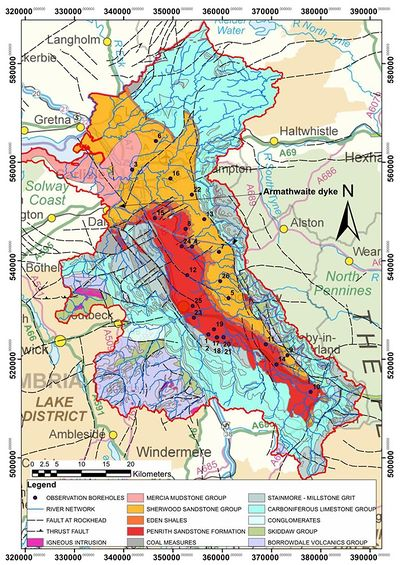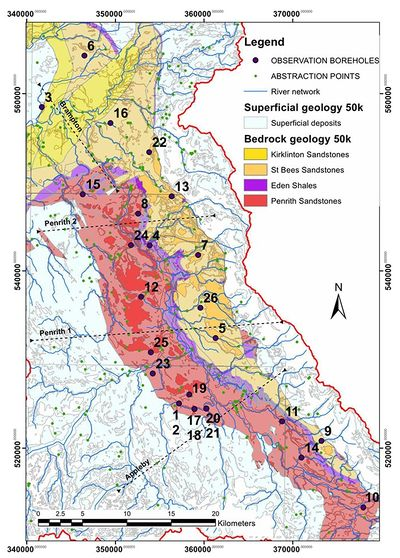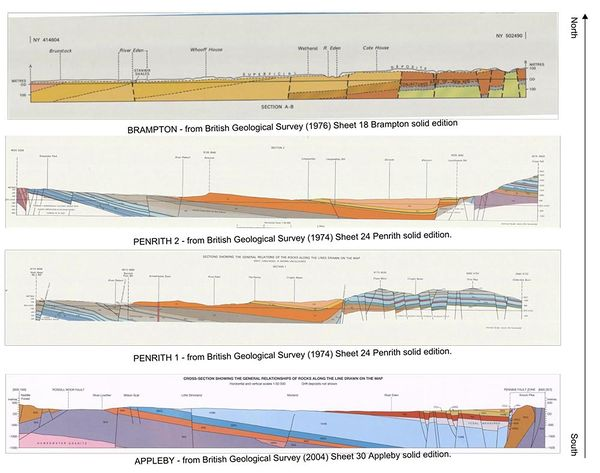OR/14/041 Geology and hydrogeology of the Eden Valley
| Lafare, A E A, Hughes, A G, and Peach, D W. 2014. Eden Valley observation boreholes: hydrogeological framework and groundwater level time series analysis. British Geological Survey Internal Report, OR/14/041. |
Geographical and geological setting
The Permo-Triassic rocks of the Eden Valley lie in a fault-bounded basin (approximately 50 km long and 5–15 km wide) that is bounded to the southwest by the Lake District and to the northeast by the North Pennines (Figure 1). This basin contains Permian and Triassic strata which dip gently to the north east (Figure 2 and cross section, Figure 3). The Pennine Fault and associated North Pennine escarpment form the eastern boundary of what appears to be a half-graben, throwing Permo-Triassic rocks against Carboniferous or Lower Palaeozoic rocks. To the west, the Permo-Triassic succession wedges out against Carboniferous strata (Allen et al. 1997[1]).

The main features of the geology of the Eden catchment are summarized below.
- Ordovician and Silurian strata form the uplands of the Lake District and also occur outcropping in a fault bounded inlier adjacent to the Pennine Fault in the southeast part of the catchment (Figure 1). These rocks are highly faulted and fractured, and include turbiditic sandstones, shales, lavas, volcaniclastic rocks, calcareous mudstones and siliciclastics.
- Devonian rocks are mostly represented by conglomerate formations which form conical hills. These conglomerates contain clasts mostly derived from the adjacent Borrowdale Volcanic Group (Figure 1). They may act as localized minor aquifers dominated by fissure flow.
- The Carboniferous formations are composed of a layered succession of limestones, sandstones, mudstones and coals which fringes much of the Eden Catchment. The lower part of the Carboniferous succession is characterized by thickly-bedded limestones, including the Great Scar Limestone, which create elevated, karstic watersheds. These pass upwards into thinner limestones which are cyclically interbedded with sandstones, mudstones and thin coals of the Yoredale Group. In the northern half of the Eden catchment Upper Carboniferous Millstone Grit Group succeeds the Yoredale and there are outcrops of Coal Measures to the west of Armathwaite and further north.
- The Permian Penrith Sandstone lies unconformably over the Carboniferous (see geological cross-sections in Figure 3), overstepping onto progressively older rocks from the Coal Measures in the north then over, Millstone Grit, Yoredales and onto the Great Scar limestone Group in the South north of Kirkby Stephen. This overstep is complicated by faulting.
- In the Great Scar Group hydraulic conductivity may be very high due to karst development but storage is likely to be quite low. In the Yoredales the limestones are often karstic, with lines of swallow holes found along outcrop. Storage and hydraulic conductivity rely almost entirely on fissure size, extent and degree of interconnection (Allen et al. 2010[2]). It is likely that the Millstone Grit Group rocks (and similarly the Coal Measures) form an aquitard where they occur and form relatively impermeable base beneath the Penrith Sandstone.
- The Penrith Sandstone formation (early Permian) was deposited in a structurally-controlled intermontane basin broadly coincident with the present Vale of Eden. These largely Aeolian sandstones reach a thickness of about 900 m in the center of the basin. The basal breccias and conglomerates locally known as Brockram become progressively more dominant southwards. It is composed of angular fragments of dolomitised limestone embedded in a strongly cemented calcareous sandstone matrix. The Penrith sandstone itself consists of well-rounded and well-sorted, medium to coarse grains. Less well-sorted finer grained sandstone beds with thin mudstone intercalations are common, mainly at the top of the sequence and at the margins of the basin, indicating episodes of fluvial deposition. In the northern part of the basin, parts of the top 100 m of the formation have been secondarily cemented by silica. Where such cement is abundant, the relief is stronger. These cemented sandstones are very indurated and have a very low hydraulic conductivity (Butcher et al. 2003[3]; Waugh 1970[4]), while beneath this zone the Penrith sandstones are moderately cemented and form some of the most permeable strata of the Permo-Triassic sandstones of the Vale of Eden (Allen et al. 1997[1]).
- The Eden Shale Formation overlies the Penrith Sandstone and consists mainly of mudstone and siltstone; sandstone, breccias and conglomerate intercalations being subordinate. Gypsum and anhydrite are present as beds, nodules, cements and veins (dissolved in places and likely to be responsible for localized high groundwater salinities). This formation is poorly permeable and acts as a confining layer capping the Penrith Sandstone.
- The St Bees Sandstone formation conformably overlies the Eden Shale Formation. The outcrop occupies the axial part of the Vale of Eden syncline. The formation consists mainly of very fine to fine-grained, indurated sandstone. Mudstone beds are generally subordinate, though increase in abundance towards the boundary with the underlying Eden Shale formation.
- The Mercia Mudstone Group is largely restricted to the Solway Basin north-west of Carlisle. Locally designed as the Stanwix Shales Formation, they typically comprise mudstone with minor sands and halite.
- The Cleveland-Armathwaite Dyke is a major Tertiary vertical igneous intrusion which cuts southeast across the Vale of Eden (Figure 1). The dyke is up to 30 m wide and has a significant influence on the catchment topography (low linear hills, and natural weir on the River Eden near Armathwaite). It is likely to have an impact on groundwater movement (Allen et al. 2010[2]) and this assertion is discussed by Younger and Milne (1997)[5].
- More than 75% of the Eden catchment bedrock geology is covered by Quaternary superficial deposits (see Figure 2). Extensive areas of exposed bedrock are mainly restricted to the Lake District, the Northern Pennine escarpment and the Great Asby Scar Limestones. Nevertheless, exposed areas of sandstone (‘drift windows’) are present, mainly in the southern part of the catchment. The stratigraphy of these deposits is complex, with interdigitations of sand, gravel, silt and clay that may each develop their own piezometric level, resulting in complex perched water tables above the bedrock formations (Allen et al. 1997[1]).
Summary of the hydrogeology
The Penrith and St Bees Sandstones are considered as the major aquifers in the Eden Valley. They are characterized by moderate-high permeability and porosity. While the Penrith Sandstone is characterized by both vertical and horizontal heterogeneity (in terms of cementation and grain size), the St Bees Sandstone tends to act as one aquifer. Regional groundwater flow generally appears to be dominated by intergranular flow whilst flow into boreholes is predominantly contributed by fractures (regionally, the fracture networks are not necessarily well connected) (Allen et al. 1997[1]).
Large areas of the sandstone aquifers are covered by superficial deposits of variable lithology (from clay to gravel) and thickness (up to 30 m in the northern part of the Eden catchment). These must have a significant impact on recharge and its distribution (Butcher et al. 2006[6]).
The limestones within the Yoredale Group and the Great Scar Limestone Group have undoubted fracture permeability as evidenced by the surface karstic features such as swallow holes, clints and grykes limestone pavements at Great Asby and Orton.
The principal aquifer types within the Eden catchment are:
- Unconfined sandstone with no, or little, drift cover.
- Unconfined sandstone with drift more than 5 m thick and an unsaturated zone within the sandstone.
- Confined sandstone, showing a groundwater level that fluctuates within the overlying superficial deposits.
- Limestone exhibiting significant fracture flow, with potentially solution enlarged fractures.
The River flow in the Eden catchment is derived from surface water flowing from adjacent uplands (Carboniferous Limestone and older formations), direct runoff within the Vale of Eden and base flow contribution from the Permo-Triassic sandstones and other aquifers.

© NERC. © Crown Copyright.

References
- ↑ 1.0 1.1 1.2 1.3 Allen, D J, Bloomfield, J P, Robinson, V K, et al. (1997) The Physical Properties of Major Aquifers in England and Wales. 312.
- ↑ 2.0 2.1 Allen, D J, Newell, A J, Butcher, A S. (2010) Preliminary Review of The Geology and Hydrogeology of the Eden Dtc sub-catchments. 45.
- ↑ Butcher, A S, Lawrence, A R, Jackson, C, et al. (2003) Investigation of Rising Nitrate Concentrations in Groundwater in the Eden Valley, Cumbria: Scoping Study. Environment Agency National Groundwater and Contamined Land Centre
- ↑ Waugh, B. (1970) Petrology, Provenance and Silica Diagenesis of the Penrith Sandstone (Lower Permian) of Northwest England. J. Sediment. Res. 40:
- ↑ Younger, P L, Milne, C A. (1997) Hydrostratigraphy and Hydrogeochemistry of the Vale of Eden, Cumbria, UK. Proc Yorks Geol Polytech Soc 51:349–366. Doi: 10.1144/Pygs.51.4.349
- ↑ Butcher, A, Lawrence, A, Jackson, C, et al. (2006) Investigating Rising Nitrate Concentrations in Groundwater in the Permo-Triassic Aquifer, Eden Valley, Cumbria, UK. Geol Soc Lond Spec Publ 263:285–296. DOI: 10.1144/GSL.SP.2006.263.01.16